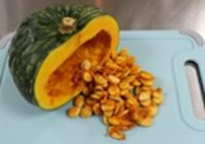Enjoying Fall Time Produce
By Amber Webb, Family Consumer Sciences Agent, Larimer County
Harvest season is still going strong in many places! The sea sonal fall bounty is ripe and ready for the picking! You may be getting gifts of extra garden produce from neighbors. Or, you have plans to visit a pumpkin patch soon. Either way, bringing home pumpkins, squash, cabbage, potatoes and apples from a local farm can be a fun day with your family. October is also a great time to shop the farmer’s market or visit your local farm stands. Fresh roasted chilies, anyone?
With an abundance of fresh fall produce available, why not try preserving some of the harvest? Learning how to preserve food can be a great skill to have. It helps you enjoy foods that are plentiful now at a later date, while helping avoid food waste. There are many delicious ways to preserve food, like freezing, dehydrating, pickling, fermenting, and canning. And many types of fresh produce can be preserved in more than one way. Freezing vegetables is an easy and delicious way to enjoy them later. Having food your children helped select and prepare in your freezer can bring back the tastes of the fall harvest all year long.
Tips for Success
The best way to determine which preserving method is right for you and for what you’ll be preserving is to review safe, tested recipes and directions for your elevation. A great place to find this information is through a website and app called Preserve Smart, developed by Colorado State University Extension. It provides a trusted way to find tested food preservation recipes and instructions. Just enter your elevation and select the type of produce you want to preserve. Then detailed instructions are immediately available at your fingertips. It includes important considerations when choosing a preservation method and the steps you’ll need to take for a successful final product.
Following these guidelines will ensure a safe, enjoyable and delicious preservation project that you and your family will be able to enjoy for months to come!
Lets Talk
Preserving food is a great way to get your kids involved in the kitchen, but some methods are more time consuming than others. They can require careful attention, planning and equipment, such as canning. However, one of the easiest and most approachable food preservation techniques is freezing food. Everyone in the family can learn how to do it right. Children can help chop fruit at the end of the week and freeze it for future smoothies or muffins. Or save cooking scraps like onions, celery, carrots and herbs in a freezer bag until it is full. Then make vegetable stock with it. Take the opportunity to talk about how in our country, 40% of food gets wasted and not eaten. Empower children to re duce food waste in your home by preserving it! Teach your family to think about if a food can be used for something else or preserved before throwing it out.
Steps for Freezing Pumpkin and Winter Squash (from Preserve Smart website)
Prepare Vegetables
- Thoroughly wash pumpkin or winter squash.
- Cut into smaller sections and remove seeds.
- Cook sections until soft (fork-tender) in boiling water, steam, microwave, pressure cooker
- Remove cooked squash from rind and mash. Spaghetti squash does NOT need to be mashed.)
- Cool thoroughly by placing the container with mashed pumpkin or squash in a tub of iced water and stir occasionally to speed the cooling process.
Pack (Dry Pack)
- Pack cooled squash tightly into freezer containers or bags.
- If using rigid containers, leave 1/2 inch headspace.
- If using flexible bags, remove as much air as possible.
- Make sure sealing edges are free of moisture or food. Seal.
Store
- Label with the name of food, date, and type of pack.
- Freeze as quickly as possible to 0°F or below.
- For quickest freezing, place containers in single layers in the freezer.
- Most frozen vegetables will maintain high quality for 12-18 months at 0°F or below.
Recipe for Health
Family Friendly Ways to Use Frozen Pumpkin or Winter Squash
Pies – Use thawed pumpkin in place of canned in your pumpkin pie recipe.
Baked Goods – Add 2-4 tablespoons of thawed pumpkin or winter squash into the batter of muffins, snack cakes or pancakes.
Smoothies – Try adding a few partially thawed chunks into your next blender smoothie.
Soups and Stews – Pumpkin or winter squash can help thicken a soup or stew and give it a creamy mouth feel without adding fat or dairy.
Visit https://apps.chhs.colostate.edu/preservesmart/ or download Preserve Smart on your mobile device for full instructions and more recipes. For more information on food preparation and nutrition, visit Food Smart Colorado at https://foodsmartcolorado.colostate.edu/.









